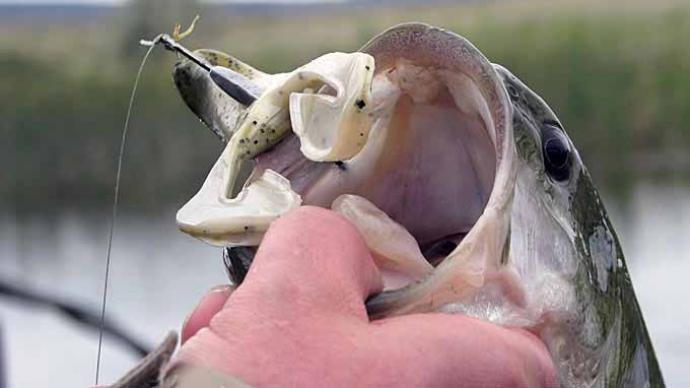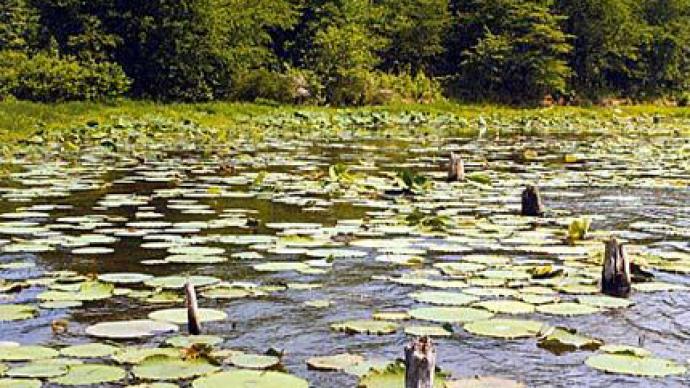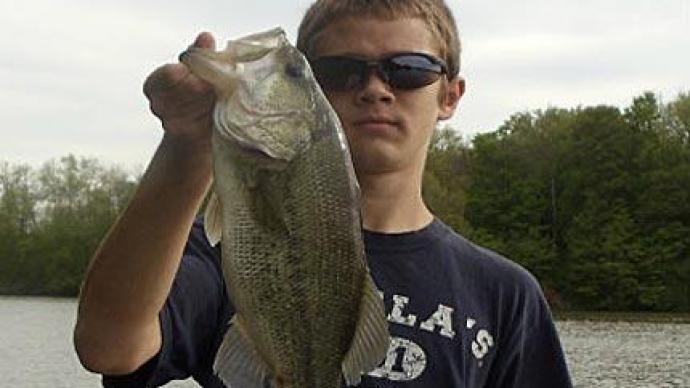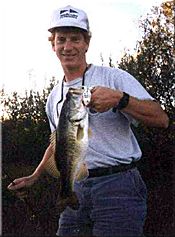
As the weather warms and springtime rapidly approaches, it is time to turn our attention from deep-water presentations to the newest, hottest thing to hit the water in a long time; The Snag Proof Tournament Frog. Yes, it is a lure that has been around for years, yet with the ingenuity of a tournament angler's mind, even old lures can have a new, more productive life.
The Tournament Frog is one of the finest lures made for drawing bass out of heavy cover. As effective as this lure is in weeds, an angler who only throws "The Frog" on emergent weed beds misses fantastic big fish opportunities over open water.
The slow and methodical rhythms produced by the Tournament Frog as an angler twitch the rod's tip seem almost annoying to large bass. Sacramento, CA tournament angler Rod Brown proved that in October at the B.A.S.S. Federation California State Classic on the famed waters of the San Joaquin Delta. By finishing second, Brown is helping to expose the open water capabilities of this lure.
The Delta is located in Northern California, with 3000 miles of shoreline that twists and winds between the San Francisco Bay and Stockton and stretches as far north as Sacramento. The Delta is a shallow fishery, rich with aquatic weeds and tules, loaded with downed trees, and bordered by riprap levees that stretch for miles.

"The River" (as it is affectionately referred to in the area) is replete with opportunities to test the limits of equipment, fish, lures, and angler limits. The Snag Proof Tournament Frog gained its fame on The Delta as the lure to use on the algae mats that emerge during the hot summer months; yet, true to their form, bass anglers find ways to push the envelope a new application for The Tournament Frog was born.
The key to the open water technique is the retrieve, "The key is always to walk the dog with the bait, but it has to move forward no more than a couple of inches." Holding the tip of his 7 1/2" Lamiglas Flipping Rod low to manipulate the lure, Brown stated that each cast would take well over a minute to complete. "I was fishing around the same cover that I was during practice, but we had a cold front roll through, so the faster presentation wasn't getting the response I needed from two-pound fish. The Tournament Frog seemed to pull better fish out of the cover." He also added, " If it wasn't for the kindness of my non-boaters each day, there is no way I would have done as well as I did. The casts were so long that it took a patient person to fish behind me. I owe many thanks to them."
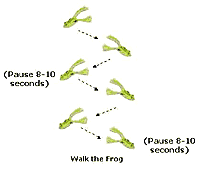
The "walk the frog" action is critical in this presentation, and the key to the action is a slackline, similar to fishing a Zara Spook. When walking a Spook, it is critical to let the lure have just enough slack line to glide sideways at a 45-degree angle, and then when you twitch again, the bait turns and glides the opposite way. It takes rhythm, but the technique is deadly.
With the Tournament Frog, the lure seems to turn in its tracks rather than gliding. This action is an annoyance that seems to anger fish into biting. "I would make my cast on the bank to avoid spooking the fish with a loud entry. Then I would hop the frog off onto the water." This is where the trick to the action comes into play. "You have to pop the frog good one time to get it to turn sideways. After that initial pop, I would twitch the bait three times, pause 8-10 seconds, and repeat, until I was past the cover, then I would reel in, and do it again."
As deadly as this technique is on bass feeding up for winter, it is equally lethal on spawning fish. On California's Clearlake, where shallow warming water brings sight fisherman running in the spring, storms can muddy water and make sight fishing nearly impossible. Walking the Tournament Frog can bring warm smiles back to a face that was left destitute by the sight of murky water on spawning beds. By pitching the frog just past the location that holds the bedding fish and imparting the walking action, the fish will rise off the bed to crush the lure. It is unclear whether the fish react out of hunger or protect their nesting area, but the strikes are sudden and vicious.
Stout tackle is paramount to this technique; bait-casting gear can handle heavy lines, and the cover is critical. Anglers should experiment with several rods to find the correct length for their tastes. Heavy action rods ranging from 6'6" to 7'6" are typically used to exert the right amount of leverage in hook settings and play wildly fighting fish. Super lines are an absolute must, the large diameter hooks of the Snag Proof Tournament Frog and bony mouths of giant bass scream for the low stretch power of the braided line. It also aids in fighting and landing fish around stumps, rocks, branches, docks, steel cables, etc.
Like any other bait, the color choice should be based on the current conditions and the angler's confidence. In keeping with that, 95 percent of the time, Brown chooses to use a white Tournament Frog, finding that his confidence is high with this color. "If you were to turn a bullfrog over and look at its belly, you would see that it is a light gray color, and I feel that a white frog best resembles that while in open water." He added, " There are a few times, specifically in low light conditions, that I will throw a black or chartreuse frog, but for the most part, I stick to white."
Modifications in the Frog can make a big difference as well. " I always open the hooks of my frogs a little. I find that it aids in the hookup percentage. I will also trim more than half of the strands from the skirt of the Tournament Frog. I think this puts less material in the way of the hooks." Some anglers choose to insert a glass worm rattle to the inside of their baits; others have removed the lead casting weight from the belly to aid the walking action. Others still have painted, marked, cut, and glued many different modifications to the lure to achieve any possible advantage.
Hook setting is critical. Like any other topwater presentation, it is vital to avoid the temptation to set the hook when you see the strike. An angler should instead wait to feel the tug on the line before slamming the hook home, then crank the reel handles hard to try and move the fish away from cover before the fish digs in.
The open water presentation earned Rod Brown a second-place California State finish, second big fish of the tournament (a 4.44-pound largemouth), a nice payday, and a trip to the B.A.S.S. Federation regional tournament in the spring of 2002 on the San Joaquin Delta... Any ideas on what he may be using to try to advance to the Federation National Championship?


